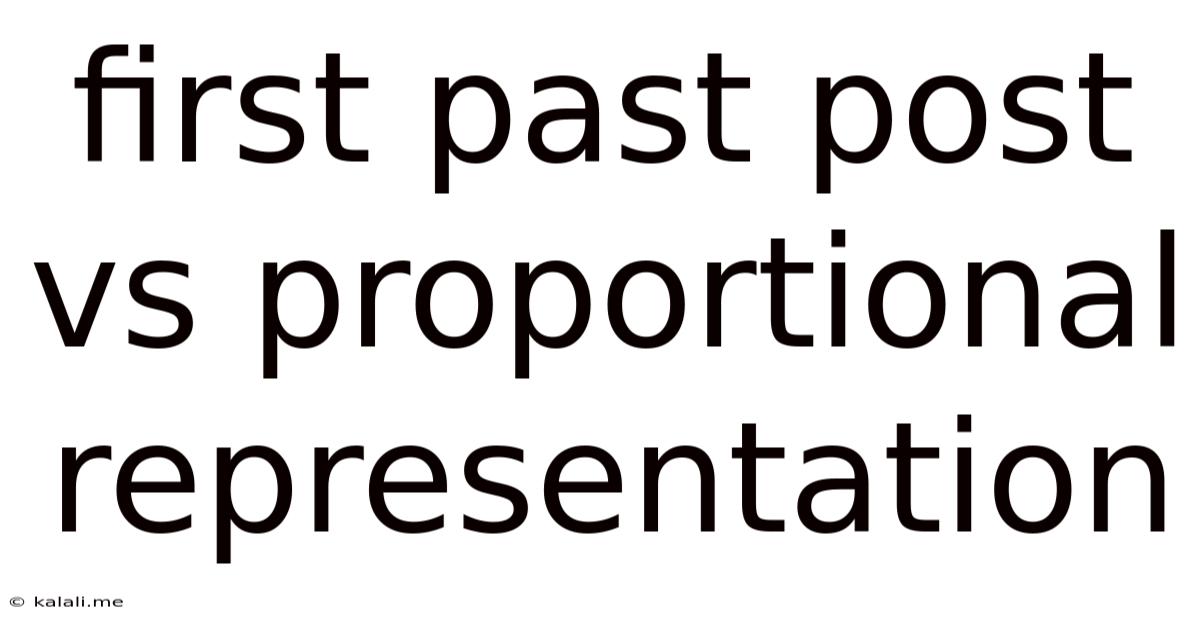First Past Post Vs Proportional Representation
Kalali
Jun 11, 2025 · 3 min read

Table of Contents
First Past the Post vs. Proportional Representation: A Head-to-Head Comparison
Choosing the right electoral system is crucial for a functioning democracy. Two prominent systems stand out: First Past the Post (FPTP) and Proportional Representation (PR). This article delves into the core mechanics, advantages, disadvantages, and real-world examples of each, helping you understand their impact on political landscapes.
What is First Past the Post (FPTP)?
FPTP, also known as "winner-takes-all," is a simple system where the candidate with the most votes in each constituency wins the seat. It's straightforward to understand and count, leading to clear winners and a strong mandate for the winning party. This system often results in a single-party government, ensuring stability and efficient decision-making. However, this simplicity comes at a cost.
Advantages of FPTP:
- Simplicity and Ease of Understanding: The process is easy to grasp, even for less politically engaged citizens.
- Strong Government Stability: Usually produces a government with a clear majority, facilitating policy implementation.
- Local Representation: Each constituency elects its own representative, fostering a direct link between voters and their MP.
- Strong Link Between MP and Constituency: MPs are directly accountable to their local constituents.
Disadvantages of FPTP:
- Wasted Votes: Votes for losing candidates are effectively discarded, leading to disproportionate results. A party might win a significant share of the national vote but gain few seats.
- Underrepresentation of Smaller Parties: Smaller parties struggle to gain traction, often failing to translate their national support into parliamentary seats. This can lead to a two-party system dominating the political landscape.
- Disproportionate Results: The winning party might secure a majority of seats with less than 50% of the national vote, undermining the principle of proportional representation.
- Tactical Voting: Voters may feel compelled to vote strategically, choosing a candidate with a higher chance of winning rather than their preferred candidate, distorting true political preferences.
What is Proportional Representation (PR)?
PR aims to allocate seats in proportion to the votes received. Various PR systems exist, but they generally share the goal of creating a parliament that reflects the national vote more accurately. This can lead to coalition governments, requiring compromise and potentially leading to greater inclusivity.
Advantages of PR:
- Fairer Representation: Parties gain seats in proportion to their votes, avoiding the wasted votes issue present in FPTP.
- Greater Inclusivity: Smaller parties have a better chance of securing representation, leading to a more diverse political landscape.
- Proportional Results: The parliament more accurately reflects the electorate's preferences.
- Reduced Tactical Voting: Voters can vote for their preferred candidate without fear of "wasting" their vote.
Disadvantages of PR:
- Coalition Governments: Often leads to coalition governments, which can be unstable and prone to internal disagreements. Compromises may dilute party manifestos.
- Complexity: The system can be more complex to understand and administer than FPTP.
- Potential for Minority Governments: Small parties may hold significant influence, potentially leading to instability.
- Weakened Link Between MP and Constituency: In some PR systems, voters elect a party list rather than a specific individual, weakening the direct link between constituents and their representatives.
Examples of FPTP and PR in Action:
- FPTP: The United Kingdom, Canada, and India utilize FPTP.
- PR: Many European countries, such as Germany, New Zealand (Mixed-Member Proportional), and Israel employ various forms of PR.
Conclusion:
Both FPTP and PR have merits and drawbacks. The optimal system depends on a country's specific political culture and priorities. FPTP offers simplicity and strong government, but at the cost of potential disproportional results and underrepresentation of smaller parties. PR promotes fairer representation but may lead to less stable coalition governments. Understanding these differences is critical to evaluating the effectiveness of democratic systems.
Latest Posts
Latest Posts
-
Write An Equation For These Two Complementary Angles
Jul 01, 2025
-
How Do You Beat Bloxorz Level 7
Jul 01, 2025
-
How Old Are You If Your Born In 1992
Jul 01, 2025
-
How Many Quarts Are In 15 Gallons
Jul 01, 2025
-
How Many Ounces Are In A Bag Of Flour
Jul 01, 2025
Related Post
Thank you for visiting our website which covers about First Past Post Vs Proportional Representation . We hope the information provided has been useful to you. Feel free to contact us if you have any questions or need further assistance. See you next time and don't miss to bookmark.